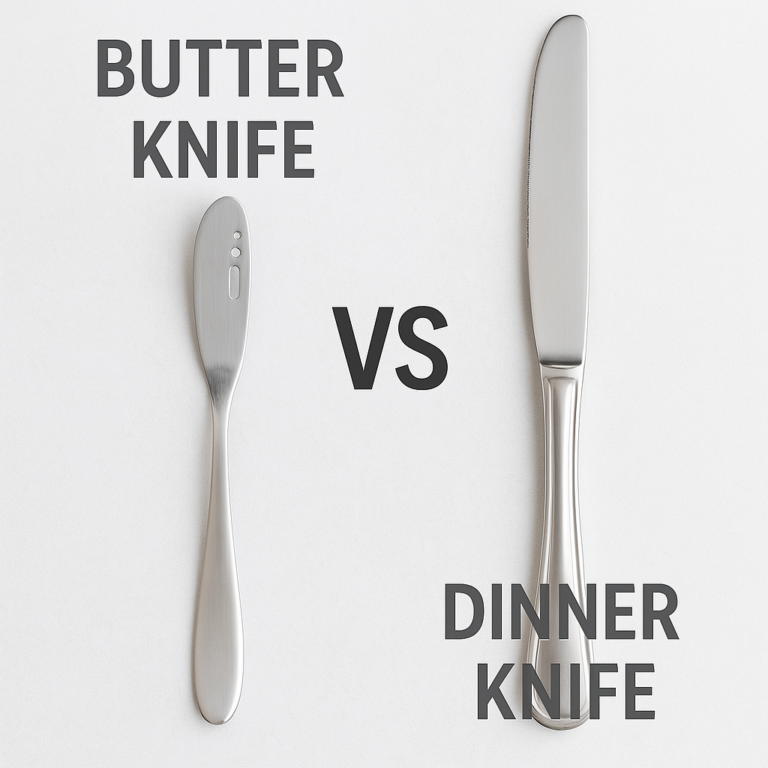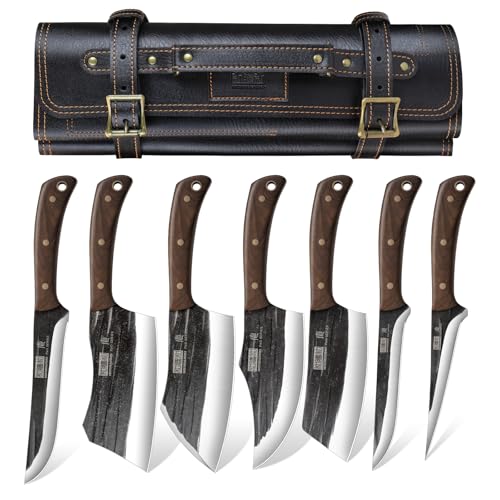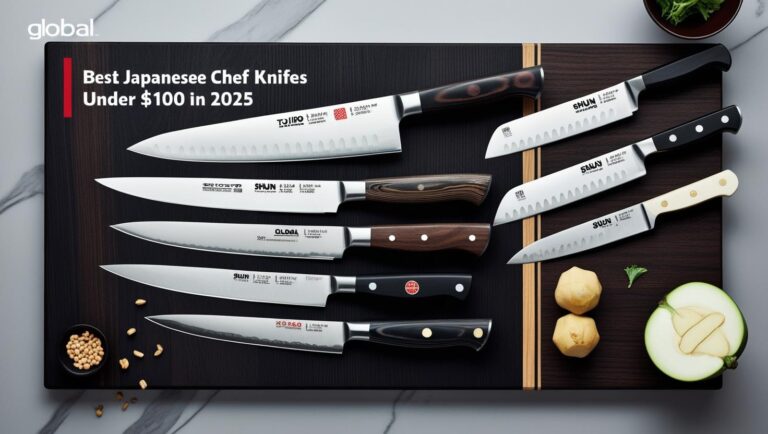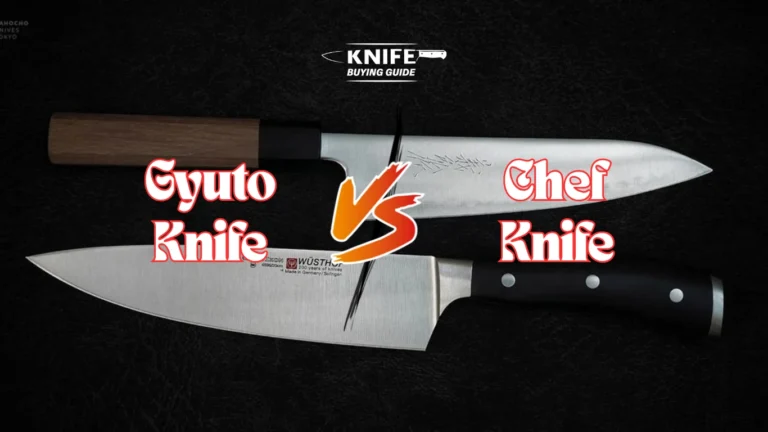Carbon Knife vs Stainless Steel: Best for Your Kitchen in 2025?
“The best knife is the one you reach for without thinking.” This quote rings especially true when choosing between Carbon Knife vs Stainless Steel. Whether you’re a home chef or a pro in the kitchen, this decision can shape your culinary experience.
Ever since I got my hands on my first carbon knife, everything changed in the kitchen. There’s something raw and powerful about how it slices—razor-sharp, responsive, and undeniably precise.
A carbon knife demands more care but rewards you with unmatched performance. I’ve come to appreciate its cutting ability and the character it develops over time. In this post, I’ll share why a carbon knife is more than just a tool—it’s an experience.
Let’s cut through the confusion (pun intended!) and help you pick the perfect knife for your kitchen.
What is a Carbon Streel Knife?
When I first started using the MOSFiATA 8″ Super Sharp Professional Chef’s Knife, I didn’t expect to be this impressed. From the moment I held it, I could tell it was more than just your average kitchen knife.
Crafted from high-carbon German stainless steel (EN1.4116), this knife balances strength, precision, and durability perfectly. The laser-engraved blade pattern gives it a premium look—note that it’s not a Damascus pattern but a stylish anti-stick design that still adds flair.
Additionally, I was blown away by the razor-sharp edge. Thanks to its hand-sharpened 16° angle per side and a high carbon content of 0.45–0.55%, it cuts through everything—from soft tomatoes to tough meat—with ease.
The 15% chrome content also makes it highly resistant to corrosion and tarnishing, which I’ve come to appreciate after weeks of use. Whether prepping a quick dinner or cooking a full spread, this knife never slows me down.
Beyond the knife, the gift box’s extras are a welcome touch. It comes with a finger guard, a blade guard, and even a knife sharpener—practical additions that show this brand’s thought about what real home cooks need. Whether you’re buying it for yourself or as a gift, it feels like a premium package all the way through.
| Pros | Cons |
| Razor-sharp edge with precise cutting power | Not an actual carbon steel knife (stainless hybrid) |
| High-carbon German stainless steel construction | The laser pattern may confuse buyers expecting Damascus |
| Ergonomic Micarta handle with excellent grip | Dishwasher safe, but hand washing is best for longevity |
| Includes knife sharpener, finger guard, and blade guard | |
| Rust and tarnish resistant |
Overall, this knife has earned a permanent spot in my kitchen. If you want a high-performing, low-maintenance chef’s knife that looks and feels premium, the MOSFiATA 8″ is a solid investment.
What Is a Stainless Steel Knife?
A stainless steel knife is a kitchen essential made from steel that contains a significant amount of chromium—typically at least 10.5%. This added chromium gives the knife its “stainless” quality, meaning it resists rust and corrosion far better than other types of steel, mainly carbon steel.
This resistance to oxidation makes stainless steel knives incredibly practical and durable for everyday cooking, especially in humid or busy kitchen environments.
Stainless steel knives don’t develop rust easily, even with minimal care, making them ideal for cooks who prioritize convenience and hygiene.
Several types of stainless steel alloys are commonly used in kitchen knives. For example, German stainless steel (like the kind used in the HENCKELS 15-piece knife set) is known for its toughness, corrosion resistance, and ease of maintenance.
On the other hand, Japanese stainless steels such as VG-10 offer better edge retention and are often sharper, but they may require more careful handling. Each alloy has strengths, so the best choice usually depends on your cooking style and maintenance habits.
Pros of Stainless Steel Knives:
- Low maintenance: Easy to clean and doesn’t require oiling or special storage
- Highly corrosion-resistant: Ideal for humid climates or frequent dishwasher use
- Durable and versatile: Great for home cooks and professionals alike
- Budget-friendly options available: Good quality can be found at a range of price points
- Dishwasher safe: Many stainless steel knives can withstand machine cleaning
Cons of Stainless Steel Knives:
- Can be harder to sharpen: Especially if the steel is very tough or treated for extra hardness
- Less edge retention: Some lower-grade stainless steels lose their edge faster than their high-carbon counterparts
- Not as sharp out-of-the-box: Often need initial honing or sharpening for best performance
Feature Carbon Knife vs Stainless Steel
| Feature | Carbon Steel Knife | Stainless Steel Knife |
| Sharpness | Extremely sharp, fine edge | Very sharp but not as fine as carbon |
| Edge Retention | Excellent — holds edge longer with proper care | Good — needs more frequent sharpening |
| Ease of Sharpening | Easier to sharpen; responds well to whetstones | Slightly harder to sharpen, especially lower-end alloys |
| Rust/Corrosion Resistance | Low — prone to rust and patina without maintenance | High — resists rust and staining |
| Maintenance Required | High — must be dried, oiled, and maintained regularly | Low — rinse, dry, and go |
| Durability | Brittle if misused; prone to chipping | Tougher overall; more forgiving |
| Aesthetics | Develops patina over time; rustic or traditional look | Polished, modern, clean appearance |
| Dishwasher Safe | No — never dishwasher safe | Sometimes marked safe, but hand wash is still recommended |
| Price Range | Mid to high (especially hand-forged blades) | Wide range — from budget to premium |
| Ideal For | Professional chefs, knife enthusiasts, daily users | Casual cooks, beginners, busy home kitchens |
| Weight & Balance | Often heavier with a solid, balanced feel | Varies widely; often lighter |
| Best For | Precision slicing, fine prep work | Versatile everyday kitchen use |
Carbon Knife vs Stainless Steel: Price Comparison
Cost is essential when choosing between carbon steel and stainless steel knives, but it’s not just about the upfront price tag. You’ll want to consider longevity, brand reputation, and the knife’s value over time.
Entry-Level vs Premium Price Points
Stainless steel knives are available at almost every price point, from affordable sets under $50 to high-end Japanese brands costing hundreds per blade. Entry-level stainless knives (like those from Victorinox or Mercer Culinary) offer solid performance for the price, especially for home cooks.
Premium stainless steel knives—like Shun, Miyabi, or Wüsthof—use advanced alloys and meticulous craftsmanship and are often priced between $150 and $300 each.
Carbon steel knives are generally more expensive at the mid- and high-tiers, although decent budget options like the Tojiro DP series or Old Hickory are available. Hand-forged artisan carbon blades from Japan or Europe (e.g., Takeda, Masamoto, or Bob Kramer) can easily exceed $300 per knife. These knives are often investments, valued for their long-term performance.
Does Carbon Pay Off Long-Term?
Yes—if properly maintained. Carbon steel knives can last a lifetime (and often get passed down) thanks to their excellent edge retention and ease of sharpening.
Stainless steel knives, especially high-quality ones, can also last decades, but they may need professional sharpening or replacement sooner if they are heavily used and not well cared for. If you’re willing to maintain carbon steel, it offers a high return on investment over time.
High-End vs Budget-Friendly
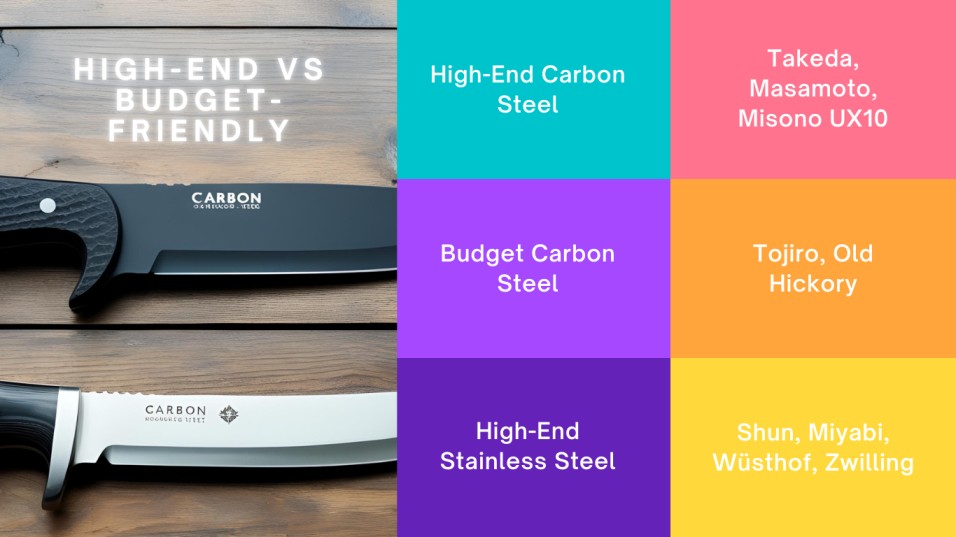
- High-End Carbon Steel: Takeda, Masamoto, Misono UX10
- Budget Carbon Steel: Tojiro, Old Hickory
- High-End Stainless Steel: Shun, Miyabi, Wüsthof, Zwilling
- Budget Stainless Steel: Victorinox, Cuisinart, Mercer Culinary
Which Offers Better ROI for Hobbyists vs Professional Chefs?
- Hobbyists may prefer stainless steel for its ease of use, minimal upkeep, and affordability. A $60–$100 stainless chef’s knife can serve a weekend cook for years.
- Professional chefs, who rely on peak sharpness and precision, often invest in carbon steel for its superior edge performance and workhorse reliability. It may take more care, but it’s worth it daily for those in the kitchen.
Which Should You Choose? Carbon Knife vs Stainless Steel
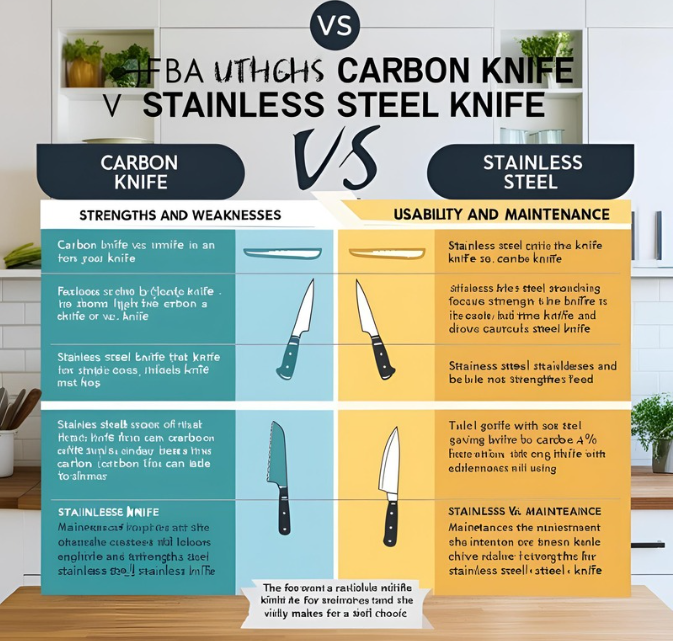
Cooking Frequency and Style
- Daily cooking or meal prep? Carbon steel might be worth it for the edge retention and sharpness.
- Occasional or casual cooking? Stainless steel is more practical and stress-free.
Time for Maintenance and Sharpening
- Short on time or not interested in maintenance? Go stainless.
- Enjoy knife care and sharpening rituals? Carbon steel will reward your effort.
Experience Level
- Beginner cooks benefit from the durability and low-maintenance nature of stainless steel.
- Advanced users often prefer carbon steel for its responsiveness and performance.
Aesthetic Preferences and Knife “Feel”
- Carbon steel develops a unique patina that reflects its use over time—some cooks love the character. It often has a more traditional, handcrafted aesthetic.
- Stainless steel maintains a cleaner, polished look and comes in more modern or industrial designs.
Quick Decision Matrix
| Factor | Choose Carbon Steel | Choose Stainless Steel |
| Cooking frequency | Daily or professional use | Occasional or light use |
| Maintenance tolerance | Don’t mind extra upkeep | Prefer low maintenance |
| Skill level | Intermediate to advanced | Beginner to intermediate |
| Sharpness priority | Extremely sharp edge | Good, practical edge |
| Budget | Willing to invest | Want best value per dollar |
| Style preference | Classic, develops patina | Sleek, modern, shiny finish |
Performance Comparison: Carbon Knife vs Stainless Steel
When it comes to kitchen performance, comparing stainless steel knives to carbon steel knives means weighing trade-offs between sharpness, edge retention, durability, and maintenance. Each type of steel has its strengths, so the best choice depends on your cooking habits and priorities.
Which Holds a Sharper Edge Longer?
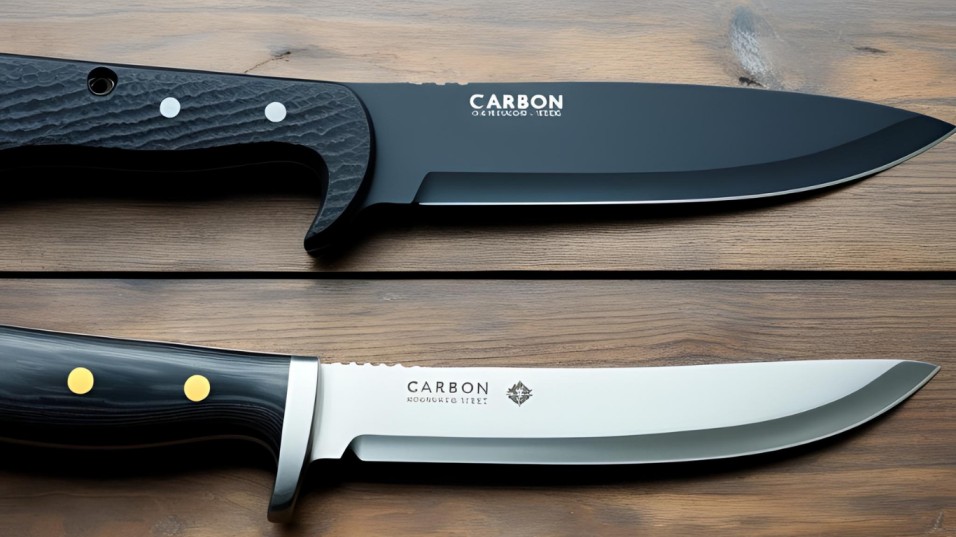
Carbon steel knives generally have the best sharpness and edge retention. Because the steel is harder and contains less chromium, it can be sharpened to an excellent edge—and it tends to stay that way longer with proper care.
Stainless steel knives, while sharp, usually don’t hold their edge as long, especially in lower-grade alloys. That said, premium stainless steels (like VG-10 or SG2) can come close to carbon steel performance, though they’re often more expensive.
Resistance to Chipping and Deformation
Stainless steel knives are more resistant to chipping, cracking, or bending, especially under rough use. Their slightly softer structure adds toughness, making them ideal for tasks that involve contact with bones or hard ingredients. Carbon steel knives, on the other hand, are more brittle. They can chip if misused—like twisting the blade or striking hard surfaces—so they demand more finesse.
Maintenance Needs After Heavy Use
After intense cooking sessions, stainless steel is much easier to care for. It resists rust, can go in the dishwasher (though hand-washing is still better), and doesn’t require oiling or special storage. Carbon steel, while superior in edge retention, needs more attention.
It must be cleaned and dried immediately after use and periodically oiled to prevent rust. Over time, it develops a dark patina—a natural oxidation layer that protects the blade and adds character—but requires consistent maintenance to manage appropriately.
User Experience: Slicing, Dicing, Chopping
For precise slicing and ultra-thin cuts—like julienning vegetables or filleting fish—a carbon steel knife feels like an extension of your hand. It bites into food with minimal pressure and offers tactile feedback that’s hard to match. Stainless steel knives provide a smoother, more forgiving experience, especially for beginners. They glide through dense ingredients and handle chopping and rougher cuts without worry.
Ideal Tasks for Carbon Knife vs Stainless Steel
- Carbon Steel Knives are best for delicate prep work, fine slicing, and chefs who want maximum sharpness and control (e.g., sushi, carving, and fine vegetable cuts).
- Stainless Steel Knives are great for everyday use, bulk prep, and busy kitchens where durability, rust resistance, and ease of cleaning matter more than edge perfection.
Maintenance & Care Requirements
Understanding how to care for your knife correctly—whether carbon or stainless steel—is essential to maintaining its performance and lifespan. Each material has unique needs for cleaning, sharpening, and storage. Here’s how they compare:
Cleaning Routines: What Each Steel Needs
Stainless steel knives are relatively low-maintenance. After use, a quick rinse with warm, soapy water and a towel dry is typically enough. They’re resistant to rust and staining, so they’re more forgiving if left wet for a short time.
Carbon steel knives, however, require immediate attention. After each use, they must be washed by hand (never soaked), dried completely, and ideally wiped down with a light layer of food-safe mineral oil to prevent rust. Any moisture left on the blade can quickly cause oxidation.
Sharpening Frequency and Tools Required
Carbon steel blades hold a sharp edge longer, so they don’t need to be sharpened as often—but when they do, they sharpen easily and cleanly. A whetstone is the preferred tool, and most carbon steel users will touch up the edge with light honing after every few uses.
Depending on the grade, stainless steel knives may need sharpening more frequently . Lower-end stainless steel tends to dull faster and is slightly harder to sharpen. A whetstone or ceramic rod works well, but many cooks also use a sharpening system or electric sharpener for convenience.
How to Prevent Rust or Patina on Carbon Steel
Always keep the blade clean and dry to prevent rust on carbon steel. Avoid cutting acidic foods (like citrus or tomatoes) unless you’re ready to clean the blade immediately afterward. Applying a thin coat of oil after cleaning forms a barrier against moisture. While patina does not rust and helps protect the blade, you can minimize or control it by washing it quickly and drying it thoroughly.
Long-Term Care Habits: Honing, Oiling, Drying, Storing
- Honing: Regular honing with a ceramic or steel rod helps maintain the edge between sharpenings for both types.
- Oiling: Carbon steel should be oiled at least once a week or more often if used daily. Stainless steel usually doesn’t require oiling.
- Drying: Always dry knives immediately after washing, regardless of steel type.
- Storing: Store in a knife block, magnetic strip, or blade guard—never loose in a drawer. This protects both the blade and your fingers.
Dishwasher Compatibility
Technically, many stainless steel knives—like those in the HENCKELS set—are labeled dishwasher safe. However, harsh detergents, high heat, and blade contact can dull and degrade the knife over time.
Hand washing is always the best practice.
Carbon steel knives should never go in the dishwasher. They will rust quickly and can be permanently damaged in just one cycle.
In short:
- Stainless Steel is more forgiving and easier to care for.
- Carbon Steel rewards you with sharpness and performance—but only if you’re willing to give it a little extra love.
Conclusion: Find the Knife That Fits Your Style
So, should you choose the ultra-sharp but high-maintenance carbon knife or the trusty, rust-resistant stainless steel blade? The right choice depends on how you cook, how much care you’re willing to give your tools, and what kind of performance you crave in the kitchen.
Knowing the differences empowers you to make the best investment for your cooking journey, regardless of your chosen path.. Need a recommendation? Check out our guides on the best carbon knives and top stainless steel picks for 2025.


